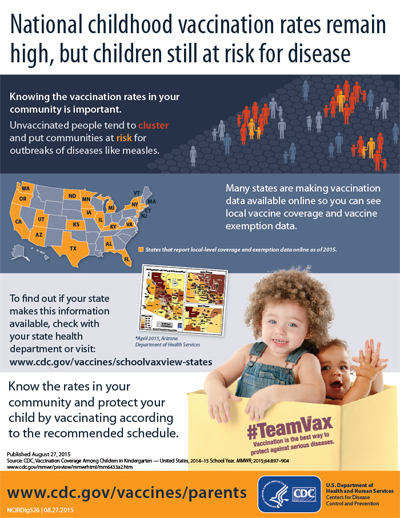State exemption levels low, national vaccination rates high
Local pockets of unvaccinated children can reveal nation’s vulnerabilities
Press Release
Embargoed Until: Thursday, August 27, 2015
Contact: 
National Childhood Vaccination Rates and State/Community Data.
Entire Infographic
Vaccine exemption levels for kindergarteners are low for most states and infant vaccination rates are high nationally, according to data from two reports published in this week’s Morbidity and Mortality Weekly Report (MMWR).
The first report looked at vaccination coverage and exemption levels among children entering kindergarten for the 2014-2015 school year. Nationally, exemption levels remain low with a median level of 1.7 percent. However, state exemption levels ranged from a low of less than 0.1 percent in Mississippi to a high of 6.5 percent in Idaho. Additionally, five states did not meet the reporting standards for providing exemption data.
The second report examined vaccination rates among children ages 19 months through 35 months for 2014. Vaccination coverage remained high: over 90 percent for measles-mumps-rubella (MMR); polio; hepatitis B; and varicella vaccines. The percentage of children who do not receive vaccinations also remained low, at less than 1 percent.
“Collaborative efforts are the reason our nation has been able to achieve such high coverage nationally, but much work is still needed to shield our schools and communities from future outbreaks,” said Anne Schuchat, MD (RADM, USPHS), director of CDC’s National Center for Immunization and Respiratory Diseases.
One important change from 2013 to 2014 was the number of states that provided local coverage and exemption data online. There was an increase from 18 states providing such data in 2013 to 21 states providing these data in 2014. Making this information available publicly keeps parents informed, guides vaccination policies, and strengthens immunization programs.
When a disease like measles reaches a community with large numbers of unvaccinated people, it can spread very quickly. Therefore, local pockets of people who are missing vaccinations can leave communities vulnerable to outbreaks.
Consistent, high coverage rates are needed to provide community immunity (herd immunity) and protect children from disease outbreaks like measles.
The CDC recommends that all children be vaccinated according to the recommended schedule. Parents with questions or concerns should talk with their child’s doctor or visit CDC’s vaccine website for parents at www.cdc.gov/vaccines/parents.
Today’s articles will be available on the Morbidity and Mortality Weekly Report website at http://www.cdc.gov/mmwr/ after the embargo lifts at 1:00 p.m. ET.
For more information on the National Immunization Survey (NIS), please visit:
http://www.cdc.gov/vaccines/imz-managers/nis/index.html
CDC’s vaccine website for parents:
www.cdc.gov/vaccines/parents
Provider Resources for Vaccine Conversations with Parents:
www.cdc.gov/vaccines/conversations
Measles
www.cdc.gov/measles